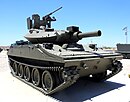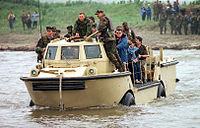Amphibious vehicle
An amphibious vehicle (or simply amphibian) is a
.Classic
General technical notes

Apart from the distinction in sizes mentioned above, two main categories of amphibious vehicles are immediately apparent: those that travel on an air-cushion (
Most land vehicles – even lightly armoured ones – can be made amphibious simply by providing them with a
For propulsion in or on the water some vehicles simply make do by spinning their wheels or tracks,
Early history

Some of the earliest known amphibious vehicles were amphibious carriages, the invention of which is credited to the Neapolitan polymath Prince Raimondo di Sangro of Sansevero[3] in July 1770 or earlier, or Samuel Bentham whose design of 1781 was built in June 1787.
The conestoga wagon, a type of a heavy covered wagon, was popular during the 18th and 19th century in the United States and Canada. The wagon was designed in such a way, as to be able to cross rivers and streams.[4]

The first known self-propelled amphibious vehicle, a steam-powered wheeled dredging barge, named the Orukter Amphibolos, was conceived and built by United States inventor Oliver Evans in 1805, although it is disputed to have successfully travelled over land or water under its own steam.[5]
Inventor
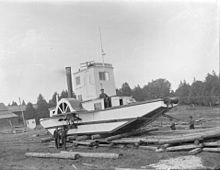
In the 1870s, logging companies in eastern Canada and the northern United States developed a steam-powered amphibious tug called an "Alligator" which could cross between lakes and rivers. The most successful Alligator tugs were produced by the firm of West and Peachey in Simcoe, Ontario.[7]
Until the late 1920s, the efforts to unify a boat and an
Since the 1920s, many diverse amphibious vehicles designs have been created for a broad range of applications, including recreation, expeditions, search & rescue, and military, leading to a myriad of concepts and variants. In some of them, the amphibious capabilities are central to their purpose, whereas in others they are only an expansion to what has remained primarily a watercraft or a land vehicle. The design that came together with all the features needed for a practical all-terrain amphibious vehicle was by Peter Prell of New Jersey. His design, unlike others, could operate not only on rivers and lakes but the sea and did not require firm ground to enter or exit the water. It combined a boat-like hull with tank-like tracks. In 1931, he tested a scaled down version of his invention.[9]
Wheeled
Unarmored
Cycles
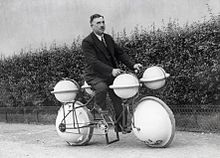
An amphibious cycle is a
The SBK Engineering Shuttle-Bike consists of two inflatable floats with straps that allow the carrying of a bicycle with a passenger. The ensemble, when deflated, fits in a backpack for carrying by the cyclist.[12]
Several amphibious cycles have been created by engineering students as university projects.
Gibbs Sports Amphibians Inc. introduced a motorized version of the amphibious cycle that resembles a jet ski on water and motorcycle on land. The model can reach up to 80 mph by land and 45 mph by water.[13]
ATVs

Amongst the smallest non-air-cushioned amphibious vehicles are amphibious ATVs (all-terrain vehicles). These saw significant popularity in North America during the 1960s and early 1970s. Typically an amphibious ATV (AATV) is a small, lightweight, off-highway vehicle, constructed from an integral hard plastic or fibreglass bodytub, fitted with six (sometimes eight) driven wheels, with low pressure, balloon tires. With no suspension (other than what the tires offer) and no steering wheels, directional control is accomplished through skid-steering – just as on a tracked vehicle – either by braking the wheels on the side in the direction of the desired turn or by applying more throttle to the wheels on the opposite side. Most contemporary designs use garden tractor type engines, that will provide roughly 25 mph (40 km/h) top speed on land.
Constructed this way, an AATV will float with ample freeboard and is capable of traversing swamps, ponds, and streams as well as dry land. On land these units have high grip and great off-road ability, that can be further enhanced with an optional set of tracks that can be mounted directly onto the wheels. Although the spinning action of the tires is enough to propel the vehicle through the water – albeit slowly – outboard motors can be added for extended water use.
In October 2013, Gibbs Amphibians introduced the long-awaited Quadski, the first amphibious vehicle capable of traveling 45 mph on land or water. The Quadski was developed using Gibbs' High-Speed Amphibian technology, which Gibbs originally developed for the Aquada, an amphibious car, which the company has still not produced because of regulatory issues.[14]
Cars
One of the most capable post-war amphibious off-roaders was the German Amphi-Ranger, that featured a hull made of seawater-resistant AlMg2 aluminium alloy. Extensively engineered, this costly vehicle was proven seaworthy at a Gale force 10 storm off the North Sea coast (Pohl, 1998). Only about 100 were built – those who own one have found it capable of crossing the English Channel almost effortlessly.
Purely recreational amphibian cars include the 1960s Amphicar and the contemporary Gibbs Aquada. With almost 4,000 pieces built, the Amphicar is still the most successfully produced civilian amphibious car to date. The Gibbs Aquada stands out due to its capability of high-speed planing on water. Gibbs built fifty Aquadas in the early 2000s after it was developed by a team assembled by founder Alan Gibbs before the company's engine supplier, Rover, was unable to continue providing engines. Gibbs and new partner Neil Jenkins reconstituted the company and are now seeking U.S. regulatory approval for the Aquada.[15]
In 2010, a Southern California-based company named
Other amphibious cars include the US Hydra Spyder and the Spira4u.[19]
-
VW Schwimmwagen in June 1944
-
"Drozd" amphibious vehicle during the "Armiya 2020"
-
ALand Roverwith inflatable floats to create a vehicle that will swim much like an improvised raft
-
Water Car Panther driving at High Speeds on Lake Havasu, AZ.
Buses
Amfibus amphibious buses made by Dutch Amphibious Transport (DAT) in Nijmegen, Netherlands are used to operate tours of Amsterdam, Rotterdam and Lübeck, under the Splashtours brand. The buses have a Volvo chassis and carry 43 passengers. The operation started in 2010 in Katendrecht, Rotterdam, was copied in Amsterdam in 2011 but suspended in 2012 after technical problems, and then relaunched in 2019.[20] A tour of Lübeck was launched in 2014.[21] In 2010 it was tested as a replacement for the ferry at Renfrew, Scotland, but not adopted.[22] A similar service, using different vehicles, operates in Porto.
-
Splashtour 'Amfibus' amphibious bus, An der Untertrave, Lübeck, 12 August 2020
-
Amphibious tour bus – a converted DUKW – on Thames river in London near Lambeth Bridge.
Boats
Some amphibious vehicles, rather than being designed for land transport with the ability to cross water, are designed as water-transport vehicles with the ability to travel on land. The distinction is that the vehicles are designed to be high performing on water, with the land transport ability added to give additional functionality, rather than being the main function.
Recently,[
-
Amphibious boat used for water maintenance
Oyster boats
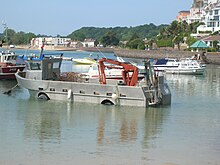
Since 1977, several boat builders in Brittany have built specialized amphibious vehicles for use in the area's mussel and oyster farming occupations. The boats are made of aluminium, are relatively flat-bottomed, and have three, four, or six wheels, depending on the size of the boat. When the tide is out the boats can run on the tidal flats using their wheels. When the tide is in, they use a propeller to move through the water. Oyster farmers in Jersey make use of similar boats. Currently, Constructions Maritimes du Vivier Amphibie has a range of models.[23]
Cargo
Trucks and barges

With more than 20,000 units produced, the
During the
For taking vehicles and supplies onto the beaches the US used the 1950s designed LARC-V and the huge LARC-LX which could carry 60 tons of cargo.
The
The M3 Amphibious Rig can be used as a ferry or as a floating bridge for trucks and heavy combat vehicles.
Gibbs has also developed other types of fast amphibians including the Phibian, a 30-foot (9.1 m) amphibian that is aimed at first responder market, and the Humdinga, a 21-foot (6.4 m) amphibian that is capable of traversing extreme terrain.[24]
-
A DUKW during World War II
-
A British Alvis Stalwart
-
A LARC-V 5-ton U.S. amphibious cargo vehicle
Armored

Many modern military vehicles, ranging from light wheeled command and reconnaissance vehicles, through
The French
During the
Tracked
Unarmored
M29 Weasel
The M29 Weasel (Studebaker Weasel), whilst originally designed as a snow vehicle, operated successfully in an amphibious role by the addition of front and rear floats. The basic vehicle will float but its bow is square so the additional floats add stability and load carrying capacity.
Armored

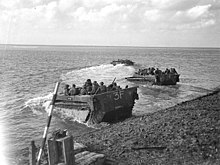
Tracked armored vehicles with amphibious capabilities include those that are intended for use in
Many tracked armored vehicles that are primarily intended for land-use, such as
Some heavier tanks have an amphibious mode in which a fabric skirt is needed to add buoyancy. The Sherman DD tank used in the D-Day invasion had this setup. When in water the waterproof float screen was raised and propellers deployed. The M2 and M3 Bradleys also need such a skirt.
Tanks
At the end of World War I a Mark IX tank had drums attached to the side and front and was tested as an amphibious vehicle launched into Hendon Reservoir.[25] A modified Medium Mark D successfully swam in a river near Christchurch.[26]
By the early 1930s, Vickers had developed an amphibious tank. By using very thin armour, flotation could be achieved without external buoyancy aids. The British Army trialled the
In World War II the British further developed amphibious tanks. The
Before World War II, The Soviets produced light amphibious tanks called the
Some
During the Cold War, the Swedish Stridsvagn 103 main battle tank carried flotation gear all the time and was, therefore, theoretically, always amphibious.
-
Vickers Carden Loyd amphibious tank
-
1944 Sherman DD (Duplex Drive) amphibious tank with float screens lowered
-
A Polish PT-76 amphibious light tank coming out of the water during an amphibious exercise
Multi-unit
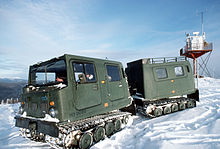
According to a 1999 article in Military Parade magazine,[28] multi-unit, all-terrain transport vehicles were first proposed by the British in 1913, and by the 1950s, over 40 types of articulated tracked vehicles (ATV) were in production. The articulated tracked concept is chosen primarily for its combination of high maneuverability, cross-country abilities, and load-carrying capacity. In some cases the design is made amphibious, giving them all-terrain capability in the truest sense. Usually, the front unit houses at least the engine, gearboxes, fuel tank(s) and the driver's compartment, and perhaps there is some space left for cargo or passengers, whereas the rear unit is the primary load carrier.
Examples of this concept are the Russian Vityaz, Swedish Volvo Bv202 and Hagglunds Bv206 designs, and the Bronco All Terrain Tracked Carrier of Singapore.
A highly specialised development is the ARKTOS Craft, that uses a linkage with two joints to connect the two units and each unit having independent drive systems, giving enhanced mobility and redundancy. They are capable of climbing large ice steps from open water.[29]
Deep fording
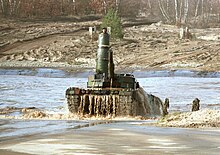
Some military vehicles are capable of "wading" using waterproof screens to keep the upper hull dry. In World War II the tanks following the
The Leopard 2 tank can use a series of rings to create a long tube. This tube is then fitted to the crew commander's hatch and provides air and an escape route for the crew. The height of the tube is limited to around three meters.
The Russian T-90 tank is also able to perform deep fording operations. The Russian snorkel is only a few inches around and does not provide a crew escape path, but it can be stored on the tank.
Some civilian deep wading vehicles achieve their capability by means of legs or stilts to raise the body of the vehicle from its wheels. One example is the sea tractor, a motor vehicle that can travel through shallow water, with driver and passengers on a raised platform. Another is the Brighton and Rottingdean Seashore Electric Railway, a coastline railway that ran on submerged rails through the shallow coastal waters of the English Channel between 1896 and 1901.
Hovercraft
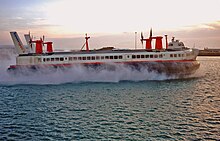
An air-cushion vehicle (ACV) or hovercraft can travel over land or water supported by a cushion of air ejected downwards against the surface below it.[30] In principle, a hovercraft can travel over any sufficiently smooth surface: solid, liquid, mixed, or anything in between. Large hovercraft, riding on an air-cushion contained by skirts several meters tall, can deal with obstacles 1 to 2 meters in height. The smallest personal hovercraft are nimble enough to follow some rolling of the terrain.
One of the benefits of this type of amphibious craft is the possibility of making them large – the British-built SR.N4 Mk.3 ferries could carry dozens of vehicles. ACVs have a high speed over water (an SR.N4 Mk.1 could do 83 knots (95 mph or 154 km/h)) and can make the transition between land and water at speed – unlike most wheeled or tracked amphibians. Drawbacks are high fuel consumption and noise levels.
For some military applications wheeled and tracked amphibious vehicles are slowly being supplanted by air-cushioned landing craft. The hovercraft's ability to distribute its laden weight evenly across the surface below it makes it well suited to the role of amphibious landing craft. The US Navy LCAC can take troops and materials (if necessary an M1 Abrams tank) from ship to shore and can access more than 70% of the world's coastline, as opposed to conventional landing craft, which are only capable of landing along 17% of that coastline.
In media
The BBC television series
The show returned to the concept in S10E02, when the presenters built updated versions of their designs with lessons learned from the first time. Clarkson built his "Nissank" out of a
See also
- Amphibian aircraft
- Amphibious automobile
- Amphibious excavator
- Float (nautical)
- Paddle
References
- ^ Hanlon, Mike (28 February 2007). "Killer amphibious vehicle - 39 mph on water and 55 mph on land". Gizmag. Retrieved 13 May 2018.
- Discovery Communications. 2 February 2010. Archived from the originalon 1 September 2010. Retrieved 13 May 2018.
- ^ "Raimondo di Sangro - Experiments and Inventions". Museo Cappella Sansevero. Archived from the original on 14 March 2014. Retrieved 13 May 2018.
- ^ "Conestoga Wagon Replica (U.S. National Park Service)".
- ^ Lubar, Steven (Spring 2006). "Was This America's First Steamboat, Locomotive, and Car?". Invention & Technology. American Heritage. Archived from the original on 22 June 2009. Retrieved 11 August 2014.
- ^ "Great Citizens - Gail Borden". Houston History. Archived from the original on 13 February 2012. Retrieved 13 May 2018.
- ^ Owen, Bryant (1999). "The Alligator or Steam Powered Amphibious Warping Tug". Duckworks. Archived from the original on 30 June 2008. Retrieved 11 August 2014.
- ^ a b Pohl, 1998.
- ^ "Strange Craft at Home on Water or Land". Popular Science. Bonnier Corporation. 1 April 1931. p. 70.
- The Tribune. Chandigarh, India.
- ^ Moraga, Ernesto Octavio (21 September 1971). "Cyclo Amphibious (US Patent 3,606,856)". Google Patents. Retrieved 13 May 2018.
- ^ Hanlon, Mike (4 June 2004). "Shuttle-Bike - convert a bike to a pedal-power boat". Gizmag. Retrieved 13 May 2018.
- ^ "Motorcycle Innovations: Introducing the Amphibious Motorcycle". American Industrial. 20 November 2015. Retrieved 9 August 2016.
- ^ Laviolette, Bryan (14 February 2012). "Attorneys: New Classification Needed for High Speed Amphibians". Fast Amphibians. Retrieved 13 May 2018.
- ^ Laviolette, Bryan (2 July 2010). "With Car/Boat Stalled, Gibbs to Launch Amphibious ATV". The Detroit Bureau. Retrieved 13 May 2018.
- ^ "Fastest amphibious car". Guinness World Records.
- ^ Lloyd, Alex (27 June 2013). "WaterCar Panther, the amphibious off-road vehicle sets sail". Yahoo! Autos. Archived from the original on 1 July 2013. Retrieved 27 June 2013.
- ^ England-Nelson, Jordan (27 January 2014). "Amphibious WaterCar is a pricey, fast boat, too". The Seattle Times. Retrieved 13 May 2018.
- ^ "About Us". Spira4u.com. Retrieved 13 May 2018.
- ^ "Splashtours: Amphibious bus ride through the canals of Amsterdam". 26 June 2018.
- ^ "Splashtour Lübeck - Splashtours bus".
- ^ "Britain's first amphibious bus nearly becomes a submarine". 11 February 2010.
- ^ "Our projects". CMV Amphibie. Retrieved 13 May 2018.
- ^ Laviolette, Bryan (9 February 2012). "Gibbs Launches 30-foot Phibian High Speed Amphibian". Fast Amphibians. Retrieved 13 May 2018.
- ISBN 1-85260-141-8.
- ^ Fletcher, David (2001). The British Tanks 1915-1919. Crowood Press. pp. 178, 185
- ^ ISBN 9781472820037.
- ^ Shangin, Vladimir (February 1999). "Vityaz Transporters From Ishumbai". Military Parade. No. 31. Archived from the original on 16 February 2012. Retrieved 15 April 2007.
- ^ "ARKTOS Craft".
- ISBN 9780850451634.
Further reading
- Ben Carlin, Half-Safe, Andre Deutsch Ltd, 1955.
- Ben Carlin, The Other Half of Half-Safe, ISBN 0-9598731-1-2, Guildford Grammar School Foundation, 1989.
- René Pohl: Mit dem Auto baden gehen. HEEL Verlag, Gut-Pottscheidt Konigswinter, 1998, ISBN 3-89365-702-9.
External links
- Sherp ATV Amphibious All Terrain Vehicle http://sherpatv.com Archived 28 June 2019 at the Wayback Machine
- UK based site all about the 1960s German Amphicar
- The A to Z 'Amphiclopy'
- "Amphibious" Land Rover
- Terra Wind,Cool Amphibious Manufacturers International
- The Museum of Creative Invention of multirole vehicles.
- A site for Amphibious ATV vehicles
- Amphibious boats on Tumblr
- Land, Air and Sea Museum




